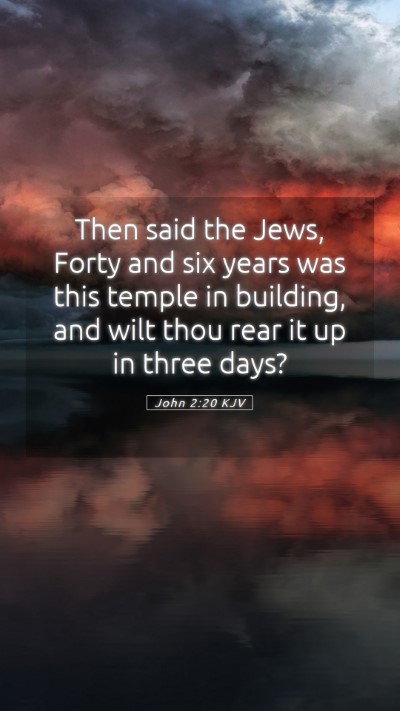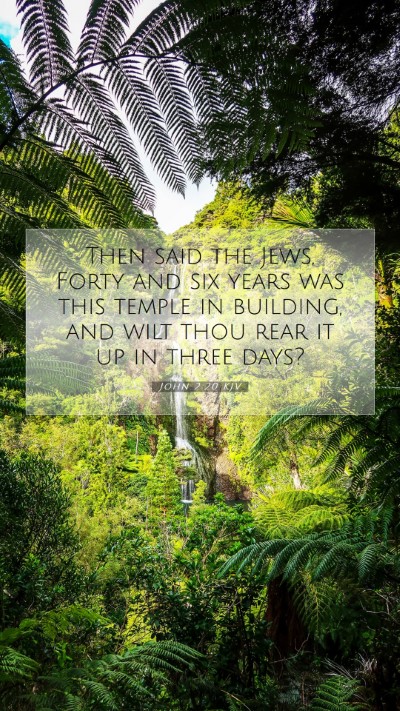Old Testament
Genesis Exodus Leviticus Numbers Deuteronomy Joshua Judges Ruth 1 Samuel 2 Samuel 1 Kings 2 Kings 1 Chronicles 2 Chronicles Ezra Nehemiah Esther Job Psalms Proverbs Ecclesiastes Song of Solomon Isaiah Jeremiah Lamentations Ezekiel Daniel Hosea Joel Amos Obadiah Jonah Micah Nahum Habakkuk Zephaniah Haggai Zechariah MalachiJohn 2:20 Meaning
What is the meaning of John 2:20?
Then said the Jews, Forty and six years was this temple in building, and wilt thou rear it up in three days?
John 2:20 Bible Verse Meaning
Understanding John 2:20: A Deep Dive into Jesus' Words
Verse: John 2:20 - "Then said the Jews, Forty and six years was this temple in building, and wilt thou rear it up in three days?"
Introduction
This verse, part of the narrative surrounding the cleansing of the temple, serves as a significant moment where Jesus' words are misunderstood by His contemporaries. It opens up avenues for deep biblical study and interpretation regarding the nature of Christ's ministry and the prophetic implications of the temple.
Commentary Summaries
Insights on this verse are drawn from esteemed public domain commentaries, which provide a wealth of biblical verse meanings and interpretations. Here is a synthesized understanding based on the insights from Matthew Henry, Albert Barnes, and Adam Clarke.
Matthew Henry's Commentary
Contextual Significance: Matthew Henry highlights that the Jewish leaders are astonished by Jesus' bold declaration regarding the temple. Their misunderstanding reveals their lack of spiritual insight and the blindness that can come from rigid attachment to tradition and physical structures.
- Historical Context: Henry emphasizes the historical backdrop of the Jerusalem temple, completed after a prolonged period of reconstruction. This adds weight to the incredulity of the Jewish leaders when they hear Jesus speak of rebuilding it in three days.
- Spiritual Implications: He points out that Jesus is prophetically speaking about His body, which will be raised after three days following His crucifixion, a metaphor that underscores the temple's ultimate fulfillment in Christ Himself.
Albert Barnes' Notes
Clarification on the Construction: Albert Barnes provides an important note on the specifics of the temple's duration of construction. Barnes notes that the temple was large and magnificent, built meticulously over decades. The Jews' reference to "forty and six years" reflects their deep-rooted cultural pride associated with the temple's grandeur.
- Misinterpretation of Jesus' Words: Barnes explains that the Jews misconstrued Jesus' statement to mean the physical temple itself rather than understanding it as a revelation of His deity and the new covenant.
- Christ as the True Temple: He also affirms that this incident foreshadows the transformation of religious practice from the temple-based system to a new worship grounded in Christ—the true temple where God and humanity meet.
Adam Clarke's Commentary
The Symbolism of the Temple: Adam Clarke explores the typology of the temple, relating its significance in the Old Testament to Jesus' fulfillment of the law and the prophets.
- Literal vs. Spiritual Meaning: Clarke contrasts the literal understanding of the temple with the spiritual metaphor that Jesus uses, emphasizing the necessity of spiritual discernment in interpreting Scriptures.
- Foreshadowing Resurrection: Clarke ties this exchange to Christ’s resurrection, noting that just as He predicted, the temple of His body would rise again, thus assuring believers of eternal life through Him.
Key Themes in John 2:20
This verse provides essential insights into key biblical themes, which can be summarized as follows:
- The Transcendence of Christ: Jesus’ authority is paramount; He reveals the inadequacies of the temple system and introduces a new way of relating to God.
- Misunderstanding of Prophecy: The initial confusion depicts a recurring theme where Jesus' teachings are often met with skepticism due to a lack of spiritual insight.
- Resurrection as a Central Doctrine: The foresight of His resurrection is foundational for the Christian faith, emphasizing hope and renewal.
Application of John 2:20 to Daily Life
Understanding this verse can greatly enrich one’s faith and application of biblical principles. Here are some ways to apply its lessons:
- Spiritual Discernment: Seek to understand deeper meanings within the Scriptures, recognizing that initial readings may not encompass the fullness of spiritual truths.
- Faith in Jesus’ Promises: Just as Jesus predicted His resurrection, believers can trust in His promises for life and restoration amidst personal challenges.
- Personal Connection with God: Move beyond ritualistic practices to cultivate a genuine relationship with Christ, the true temple.
Cross References
This verse correlates with several other biblical passages, enhancing its meaning and application:
- Matthew 26:61: Where false witnesses claim Jesus said He could destroy the temple and rebuild it in three days.
- John 10:18: Jesus speaks of His authority to lay down His life and take it up again, reinforcing the theme of resurrection.
- 1 Corinthians 3:16: Paul teaches that believers are the temple of God, indicating that Christ’s legacy continues in His followers.
Conclusion
John 2:20 serves as a pivotal moment in Jesus’ ministry, encapsulating vital messages about misunderstanding, the role of Christ, and the transition from old to new covenants. Through careful biblical exegesis, one gains invaluable Bible study insights that illuminate the profound truths within Scripture.
For anyone engaged in Bible study groups, exploring these commentaries will enhance your understanding of Scripture, provide tools for online Bible study, and inform discussions on significant biblical topics.


